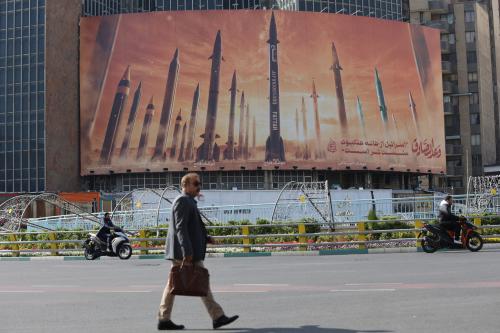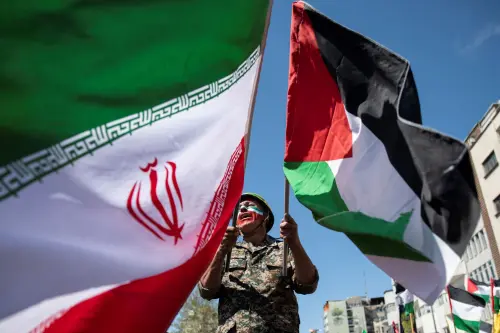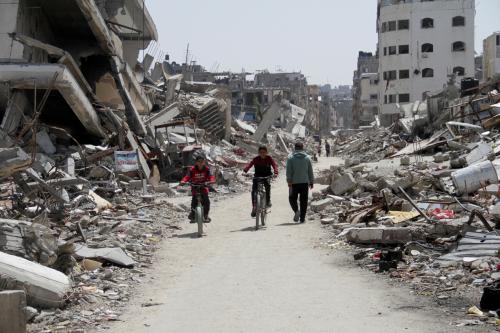The Caspian Basin and the surrounding states of the Caucasus and Central Asia have crept from obscurity onto the U.S. foreign policy agenda. While the individual countries of the two regions may not be of vital interest to the United States, the countries that border them are. Four have nuclear weapons, one is an important NATO ally, and two are states that have posed direct challenges to U.S. security by their support for terrorist movements.
There is great potential for interstate conflict involving these border countries. So even if the United States did not consider the Caucasus and Central Asian states of vital interest, it might be drawn in by the actions of others. Keeping the regions off the crisis response list should be a priority for the U.S. and Western governments.
POLICY BRIEF #80
A number of developments in the Caucasus and Central Asia underscore the need for the United States and its allies to pay closer attention to the area around the Caspian Basin. The border states of Russia, Turkey, Iran, Afghanistan, China and, more distantly, Pakistan and India, have close links with the region and are critical to U.S. foreign policy. The Caspian Basin itself has become one of the principal points of tension in U.S.-Russian relations, and the Caucasus and Central Asia are focal points for a range of issues on America’s global agenda: the rise of militant Islamic groups, international terrorism, drugs and weapons trafficking, human rights abuses, ethnic conflicts, humanitarian disasters, environmental catastrophe, and energy security.
In the next two years, the Caucasus and Central Asian states could become zones of interstate competition similar to the Middle East and Northeast Asia. Economic and political crises, or the intensification of war in Chechnya or Afghanistan, might lead to the “Balkanization” of the regions. This, in turn, could result in military intervention by any of the major powers. Given the fact that both Turkey and Iran threatened intervention in the Caucasus at the peak of the Nagorno-Karabakh war in 1992-1993, this risk should be taken seriously.
Unfortunately, the Caucasus and Central Asian states lack the capacity to tackle crises without outside help. Economic collapse has produced social dislocation and extreme poverty. Widespread corruption and the entrenchment of aging leaders and their families have eroded support for central governments and constrained the development of a new generation of leaders. The internal weakness of the Caucasus and Central Asian states, combined with brutal regional wars, makes them extremely vulnerable to outside pressure—especially from Russia. Although Russia itself is weak, it is far stronger than all the states combined, and while its direct influence over their affairs has declined since the collapse of the Soviet Union, it remains the dominant economic, political, and military force.
The West will have to assist the states in bolstering their institutional capacity and in promoting cooperation among them. American engagement remains crucial given its weight on the international stage, the potential threats to its own security, and the fact that it has leverage in the regions. In spite of a few glitches, the Caucasus and Central Asian states have been receptive to the United States and are among its few potential allies in a zone where other states are not so amenable to U.S. activity. Regional countries need American moral and material support to maintain independence in the face of increasing pressures, and its guidance in dealing with presidential transition crises and addressing human rights abuses. Even with limited political and financial resources, U.S. leadership can do a great deal to defuse regional tensions and mitigate problems. However, this will only be possible if a policy is defined early and communicated clearly, if there is a particular focus on partnership with European allies in addressing regional challenges, and if Russia is encouraged to become a force for stability rather than a factor for instability in the regions.
The Caucasus and Central Asia at a Crossroads
This is a critical time for the Caucasus and Central Asian states because a number of negative trends could converge to bring about a crisis. Responding to that crisis requires the United States to build a long-term strategy based on a frank assessment of regional needs and of U.S. capabilities and resources.
The Clinton administration’s approach to the regions was ad hoc. It tackled a laundry list of initiatives in response to crises and shifting policy priorities. Issues such as oil and gas pipelines, conflict resolution, and human rights were targeted at different junctures, but an overall strategy—which was essential given limited government resources for the regions—was never fully articulated. As a result, American priorities were not communicated clearly to local leaders, resulting in frequent misinterpretations of intentions. Domestic constituencies in the United States undermined leverage in regional conflicts. Incompatible government structures and conflicting legislation fostered competition among agencies and encouraged a proliferation of parallel initiatives, while congressional mandates limited areas in which scarce funds could be applied and thus reduced flexibility. The new administration must get ahead of this negative trend in setting policy and priorities, while tackling U.S. government deficiencies directly. In crafting policy, several developments need to be considered:
The civil war in Afghanistan will likely regain momentum this summer. Already, the incursion of refugees and fighters from Afghanistan into Central Asia and the activities of Central Asian militant groups have strained fragile political situations in Tajikistan, Kyrgyzstan, and Uzbekistan.
Governments in Central Asia are violating human rights as they clamp down on Islamic groups in response to acts of terrorism and militant activities. In Uzbekistan, the closing of mosques, a ban on political opposition movements, and arrests of practicing Muslims have forced groups underground and increased support for insurgencies and extremists.
In Chechnya, the war shows little sign of resolution through political negotiation. Refugees and fighters have been pushed across borders into the South Caucasus by Russian troops, as well as into neighboring Russian regions. As in Afghanistan, an intensification of the war in Chechnya is likely this summer.
Other Caucasus civil wars are in a state of “no peace, no war.” Recent international efforts to resolve the conflict over Nagorno-Karabakh, led by the United States, France, and Russia, have raised expectations for a peace settlement. But, in both Armenia and Azerbaijan, opposition figures openly discuss the resumption of war if leaders are perceived to have sold out.
Georgia is teetering on the verge of collapse, overwhelmed by internal difficulties and burdened by the inability to combat corruption and tackle economic reform. The dual secessions of South Ossetia and Abkhazia have split the country and spillover from Chechnya has soured relations with Russia. In winter 2000, Russia imposed new, stringent visa requirements on Georgia and temporarily suspended energy supplies over payments and a contract dispute, increasing pressure on the beleaguered country.
In both Georgia and Azerbaijan, political succession has become a critical issue. Turkmenistan, Uzbekistan, and Kazakhstan will soon face the same crisis. No provisions have been made for a presidential transition, and emerging leaders have often been suppressed or forced into exile.
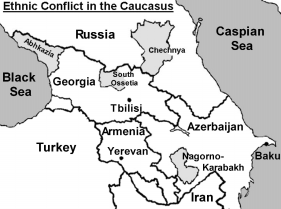 All of these issues are exacerbated by the continued downturn of regional economies. The Asian and Russian financial crises of 1998 were a major setback, leading to the devaluation of currencies, untenable debt burdens, and the withdrawal of foreign investment. Deep-rooted corruption feeds into the economic crisis and hinders the emergence of small and medium-sized businesses that could spur market development and economic growth.
All of these issues are exacerbated by the continued downturn of regional economies. The Asian and Russian financial crises of 1998 were a major setback, leading to the devaluation of currencies, untenable debt burdens, and the withdrawal of foreign investment. Deep-rooted corruption feeds into the economic crisis and hinders the emergence of small and medium-sized businesses that could spur market development and economic growth.
For both regions, Russia is the only source of reliable employment, a significant market for local products, and, in the short-term, the principal energy supplier. In Georgia alone, approximately 10 percent of the population currently works in Russia and sends home an amount equivalent to nearly a quarter of Georgia’s Gross Domestic Product (GDP). This influx of economic migrants has exacerbated ethnic tensions within Russia. Because regional governments cannot pay their energy bills, clashes over energy with Russia will continue, increasing tensions and instability.
In Central Asia, high unemployment fosters the smuggling of raw materials and consumer goods, and trafficking in arms and drugs. Eighty percent of heroin sold in Europe originates in Afghanistan and Pakistan and about half of this production flows through Central Asia. The heroin trade in Central Asia has created a burgeoning intravenous drug problem and an HIV/AIDS outbreak that mimics the early epidemic in Africa. Health workers fear an escalation in a matter of months that will overwhelm local medical systems and the region’s miniscule international programs. A major HIV/AIDS crisis would be the final straw for states like Tajikistan and Kyrgyzstan.
U.S.-Russian Tensions in the Caspian Basin
Converging with this regional crisis is a sharp difference of opinion between the United States and Russia over U.S. involvement in Caspian energy development and engagement in the Caucasus and Central Asia. In Moscow, the United States is portrayed as purposefully weakening Russia’s strategic position and bent on establishing Central Asia and the Caucasus as U.S. outposts. Where American policymakers speak of intervention in a positive sense to promote regional cooperation and stability, Russian political commentators speak of American “vmeshatel’stvo”—literally, negative intervention—to constrain Russia. The United States and Russia are at odds politically and semantically in the Caspian.
Because approximately 50 percent of Russia’s foreign currency revenues are generated by oil and gas sales, the Putin administration has made increasing Russian energy exports to Europe a priority. Caspian energy resources play a major role in Russian calculations. Gas from Kazakhstan and Turkmenistan flows into the Russian pipeline system, where it supplies the Russian domestic market and supplements Russia’s European exports. Russia is the largest supplier of gas to Turkey, and has begun constructing a new Black Sea pipeline (“Blue Stream”) to increase supplies. But gas flowing to Turkey from Kazakhstan, Turkmenistan, and Azerbaijan—and bypassing Russia—could pose direct competition. Over the last five years, U.S. policy in the Caspian Basin has promoted multiple gas and oil pipelines to world markets to increase export options for regional states, persuading Moscow that the United States seeks to squeeze Russia out of regional energy development.
Beyond energy issues, Russia sees itself caught between NATO to the west and chaos to the south. In the Caucasus, Russia has lost its strategic defensive structures against NATO’s southern flank in Turkey. Moscow perceives this loss as significant, given NATO expansion east and the alliance’s willingness to use force in the extended European arena. Explicit statements of intent to join NATO by Georgia and Azerbaijan have angered Russian policymakers, along with the active involvement of regional states in NATO’s Partnership for Peace Program, and the formation of a regional alliance among states that have opted out of the Russian-led Commonwealth of Independent States security structures (the so-called GUUAM group of Georgia, Ukraine, Uzbekistan, Azerbaijan, and Moldova).
Although Central Asia is less a zone of competition because of shared concern about Afghanistan, which resulted in unprecedented U.S.-Russian collaboration on UN sanctions against the Taliban in December 2000, U.S. bilateral military relations with regional states still alarm Moscow. The fact that an energetic Pentagon moved faster than the State Department to engage Central Asian counterparts has led Moscow to view U.S. actions in both regions with deepening suspicion.
Crafting U.S. Policy
To address these issues, the Bush administration will first have to recognize that the Caucasus and Central Asia are a major factor in U.S.-Russian bilateral relations. Russia does not only view its dealings with the U.S. through the prism of NATO, missile defense, and non-proliferation issues, although these are currently the United States’ top security priorities in the relationship. Russia’s southern tier is now its most sensitive frontier and the Caucasus and Central Asia are its number one security priority.
Having recognized this fact, the Bush administration must present a unified front when dealing with Moscow and the region, and prevent the various agencies from acting in conflict with each other. The administration needs to articulate a message that is positive and inclusive for Russia as well as regional states and stick to it. It should emphasize regional stability, cooperative relations, political solutions to conflicts, border security, human rights, institutional development, orderly successions of political power, anti-corruption efforts, and opportunities for citizen participation in political and economic decisionmaking.
Although this framework would not be considerably different from the general themes of the Clinton administration, the notion of explicitly recognizing the importance of the Caucasus and Central Asian regions in the bilateral U.S.-Russian relationship—and staying focused—would be a departure. The primary goal should be to encourage Russia to adopt a positive approach to relations with its neighbors that eschews commercial and political bullying. To this end, the administration will have to maintain a direct dialogue with its Russian counterparts in working out a practical approach for the Caucasus and Central Asia.
With its message clear, the administration needs to bring its bureaucratic mechanisms in line to focus on key issues and countries. Even if responsibility for the Caucasus and Central Asian states is divided within government departments, effective structures will have to be created to preserve links between the regions, and conflicting legislation will have to be streamlined to resolve interagency conflicts over responsibilities. This will require the executive branch to work closely with Congress to reconcile appropriations with a comprehensive program for the regions and to articulate U.S. interests through public hearings and testimony. If the administration has appropriate mechanisms in place, some policy innovations should be considered to address regional problems:
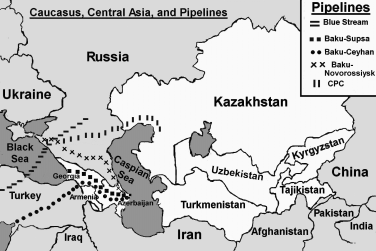 Rethink the U.S. Approach to Central Asia
Rethink the U.S. Approach to Central Asia
The Central Asian states require the most serious reassessment in U.S. policy. Central Asia is rapidly becoming a base for extremism and terrorism, and the U.S. needs to look ahead to avert its “Afghanicization.” The pivotal states for regional security are Uzbekistan and Tajikistan, which both border Afghanistan. The United States has bilateral military relations with Uzbekistan, but is barely present in Tajikistan, where permanent U.S. representation has been withdrawn because of fears for the safety of Embassy personnel. The Bush administration must change the American approach to both countries by emphasizing human rights and cooperative regional relations in Uzbekistan (rather than simply security), and by increasing its focus on Tajikistan.
Productive relations between Uzbekistan and its neighbors are key to regional stability. Tajikistan and Kyrgyzstan have significant Uzbek diasporas and are dependent on Uzbekistan for cross-border communications and energy supplies. Uzbekistan has frequently used this leverage to negative effect with these vulnerable neighbors. The United States should encourage high-level discussions between Uzbekistan and its neighbors that would address border access and gas deliveries as well as militant incursions across the Tajik and Kyrgyz borders into Uzbekistan.
Of all the regional states, Tajikistan is the most receptive to outside assistance, serving as a potential model for dealing with Islamic and political opposition. The Tajik government engaged its opposition in a dialogue that resulted in power-sharing arrangements and an end to a five-year civil war. Given the precipitous decline of the Tajik economy, even the reestablishment of a permanent U.S. embassy—with appropriate security precautions—and a modest increase in aid programs related to job creation and health would be a major boost.
Link Human Rights and Security
As a general rule, the administration should engage Central Asia without reinforcing authoritarian regimes. In Uzbekistan, while militant groups are real threats to the state, human rights abuses are an equal threat and increase sympathy for the militants. The United States has considerable leverage with Uzbekistan through its military engagement activities. In 2000, Uzbekistan came close to losing congressional certification for these programs, and the Pentagon placed greater emphasis on human rights in its special forces training curriculum. Taking this as a cue, the Bush administration should emphasize mutually-reinforcing security and human rights objectives throughout Central Asia and should encourage cooperation among the Pentagon, State Department, and international human rights groups on security-human rights linkages. The administration should also emphasize U.S. support for regional non-governmental organizations (NGOs) that seek to increase both citizen participation in government and access to objective sources of information.
Spotlight HIV/AIDS in the War on Drugs
While the United States and international organizations have paid some attention to tackling drug trafficking in Central Asia by funding border security and local interdiction efforts, the public health dimension has not been addressed. The growing HIV/AIDS epidemic along drug routes in Tajikistan, Kyrgyzstan, and Kazakhstan threatens to undermine the region’s meager economic and political achievements. The emergent public health crisis must be part of the U.S. and international agenda for the region and funding should be allocated for HIV/AIDS prevention programs and for NGOs working directly with intravenous drug users, women’s groups, and regional youth.
Factor in Other Regional Players
During the Clinton administration, the United States had an Osama bin Laden policy but no Afghanistan policy, and increasingly lost sight of a wider Central Asian policy as Afghanistan-related security concerns increased. But without stability in Afghanistan, local governments can do little to tackle the movement of militant groups or drugs and arms trafficking across the Afghan border. Active U.S. engagement with Pakistan is key to addressing the crisis in Afghanistan. Likewise, Iran is an important player in the dynamic of Caucasus and Caspian energy politics, but was routinely excluded from regional calculations by U.S. policy. A rapprochement between the United States and Iran would effect a seismic shift in regional geopolitics and pave the way for increased cooperation among the states of the Caucasus and Central Asia. When crafting its strategy, America must consider how bilateral relations with all the neighboring countries will effect developments in the two regions.
Engage Europe
Central Asia and the Caucasus have become Europe’s backyard, and the European Union and key states like Germany are beginning to formulate long-term plans for engagement with the regions. Over the next decade, if Turkey and the Eastern European and Baltic States accede to the Union, Russia will be the only country separating an expanded Europe from Central Asia and Afghanistan. As North Sea energy reserves diminish, Europe will also put greater emphasis on Caspian energy.
Given limited resources, the United States should work with European allies to identify a long-term strategy for the regions that is targeted to respond to their most acute needs and not just to the priorities of donors. The European Commission has a substantial aid program and has spent almost one billion Euros in the Caucasus alone since 1991. But the Commission is bureaucratic and slow, and European diplomats acknowledge that assistance has been poorly targeted with little positive effect on regional stability and development. The United States may not be able to work directly with the Commission, but many European Union member states have bilateral assistance programs and could be brought into task forces for individual states. The United States has already cooperated with France on conflict resolution in Nagorno-Karabakh, and with Great Britain and Germany in providing security assistance to Georgia. Close German relations with Russia and increasing German interest in Central Asia offer additional opportunities for a transatlantic dialogue on regional stability.
Work With Europe to Seek a Political Solution in Chechnya
Chechnya is one of the primary threats to regional stability and the linchpin in Russia’s relations with the South Caucasus. Without movement toward a solution, the war will drag on, bringing Russia into increasing confrontation with Georgia and Azerbaijan, and exacerbating an already catastrophic humanitarian situation in the Caucasus. Chechnya deserves as much international attention to resolution as Northern Ireland and Palestine, but the United States and Europe have frequently been at odds in their approach. In its dialogue with Russia, the Bush administration should continue to emphasize the importance of a political solution to end the war, and keep the issue high on the transatlantic agenda.
Maintain the General Thrust of Energy Policy
The Clinton administration spent significant political capital on promoting multiple oil and gas pipelines from the Caspian and the construction of the Baku-Tbilisi-Ceyhan pipeline across the Caucasus to Turkey. Pipeline diplomacy often overshadowed other American initiatives in the regions. As a result, some American policy analysts propose that the new administration step back from this policy. But, after five years of intensive engagement, Baku-Tbilisi-Ceyhan is already a regional political reality, even though it has yet to be built. Repudiating this policy now would be tantamount to a repudiation of U.S. engagement in the Caspian and relations with Azerbaijan, Georgia, and Turkey, the strategic partners in the venture. The general policy should continue, but it should be brought in line with broader economic development priorities and initiatives that address the immaturity and fragility of regional political institutions.

